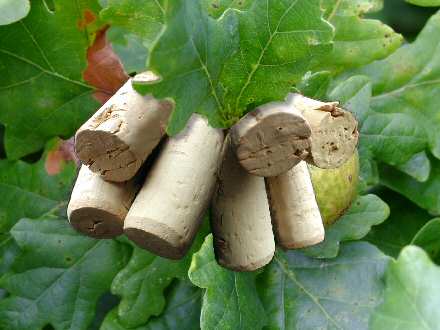|
Long thought extinct through disease pressure and natural selection, a rare species of oak has been rediscovered thriving in the wilds of rural Herefordshire.
Cultivation of the original English Cork Oak Quercus suber anglis amphorii was widespread throughout the South West and South Midlands regions of Britain. The acorn-like fruits from these trees were ideal in size and texture to seal the contents of bottles of fermented juices and preserves.

As can be seen from this picture, bottle neck size was designed to fit the stopper, the natural English Cork Oak cork.
Consequently, many glass bottle manufacturers across Europe took their design measurements from this standard. The extensive use of glass bottles to contain beverages such as cider, perry, beer and fermented liquour demanded a high cork output from the foresters of South West England and many acres of virgin land were cleared and planted with Cork trees.
Since the cork harvest was essentially annual, local labour was employed to gather the ripe fruits during the months of September to October. A vast quantity of corks were collected and stored in dry conditions to cure and await bagging up in the Spring for delivery to bottling plants.
English Oak corks were in high demand across Europe for Spring bottling of the previous season's harvest. Top quality European drink suppliers required the excellence and eminence that English corks added to their product.
Unfortunately, during the period 1845-57 a combination of weather conditions and Phytophthora infestans which led to the great potato blight in Ireland and Phytophthora ramorum "Sudden oak death", (both present day pathogens) wiped out the indigenous Quercus suber anglis amphorii.
Demand exceeded supply and so inferior cork substitutes taken from the bark of the "Cork Oak"Quercus suber, grown in Mediterranean climes have been used since this time to seal bottle necks. Is this why there are no more English Cork Oaks?
Local naturalist Theresa Gonn reports:
“A young lady in the pub showed me a picture of a tree. I went to investigate and lo and behold it looked exactly the same as drawings of the long extinct English Cork Oak I had seen in the British Museum. I’m afraid I’m not at liberty to tell you the location of this very rare find”.
When interviewed, the finder Ms Cherry Freelydunn, 17, said:
"We discovered in lovely woodland a tree we had not seen before. It had the strangest dangly fruits of ever, ever. I took a snap of it on my iPhone and showed it to a lady in the pub. Am I on telly?"
|